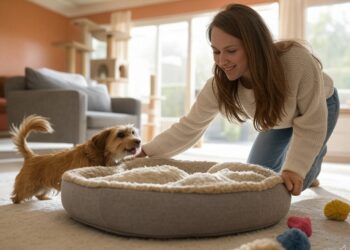Dogs are not just the most wonderful pets, they are also a symbol of dedication and trust. They are our best friends and demand our respect. Just as a human being has different types of personalities, dogs also have different kinds of qualities. They are known to sleep anywhere, but they have a specific sleeping style that is not random.
Dog sleeping habits tell us how a dog is feeling. By understanding the various dog sleeping positions you can better comprehend your pooch’s behavior. This article will discuss dog sleeping positions meaning and also give you tips on how to improve your pup’s sleep behavior.
Common dog sleeping positions
Here are a few different dog sleeping positions.
On The Side
Canines who sleep on their side often do so to conserve energy. When they are feeling down or stressed, this position allows them to rest and relax without requiring too much movement. This position is especially beneficial for pooches who suffer from hip dysplasia or other joint issues. It helps to keep their spine and joints aligned, and also prevents them from rolling onto their back.
Curled Up
Most dogs curl up when they sleep to protect their vulnerable bellies and spine. Curling up also provides insulation from external stimuli, including wind and cold weather. Some canines will snore when they are curled up because of the obstruction of airflow over their noses and mouths. When your dog curls into a ball, offer them some toys or treats so that they can expend some energy without disturbing their slumber.
Sprawled Out On The Tummy
Dogs who sleep on their tummies often have a more active sleeping pattern. They will be constantly moving around and may even wake up frequently during the night. This position is ideal for pooches who aren’t bothered by noise or light, and it helps to redistribute body weight to reduce pressure on joints. If your pup has had surgery or an illness that weakened his immune system, this is also a good position for him to sleep in.
Back-To-Back
In this position, your dog is lying on their back with their head and shoulders supported by you, and its paws resting on your lap. This is a comfortable position for both you and your furry friend, as it allows them to rest their head and neck without strain.
Back-to-back is a great way to keep your canine quiet and content, as they will be less likely to stir or make any noise while you sleep. Furthermore, this position also helps to keep your dog warm when the weather outside is cold.
Dog Sleeping Behaviors
Circling and digging
Most dog owners know that their pets love to sleep near them, but few are aware of the specific behaviors that their furry friend goes through before sleep. Dogs typically circle and dig before bedtime in an attempt to get as close as possible to their owners and to feel safe.
This behavior is instinctual and has been observed in many different dog breeds, ages, and genders. By understanding why your dog is doing this, you can help him relax and fall asleep easier.
Dog twitching in sleep
Some dogs will twitch or move around a lot in their sleep, especially if they are restless or have anxiety issues. This is usually just the dog trying to find a more comfortable position and doesn’t mean that he’s dreaming or experiencing any real danger.
If you feel like your pup is constantly moving during sleep, try putting him in another room until he falls asleep. If this doesn’t work, you might want to consult a veterinarian about possible causes of his sleep problems.
Dog seizures while sleeping
Some dogs will have seizures while they sleep, usually when they are calmer and more relaxed or if your pup has any brain disorders or injury (clean bone fractures aren’t common). If you notice this happening, be sure to wake your pup up as soon as possible and contact your veterinarian. Seizures can cause a host of side effects, including drooling, panting, and even vomiting.
How to Help Your Dog Sleep Better
Attempting to help a pooch sleep better can be as challenging as getting them to be comfortable when trimming their nails with a dog nail grinder but if it’s done carefully and with patience, both dog and owner stand to benefit from the experience. If you’re finding that your dog is constantly waking up during the night, there are a few things that you can do to help him get more rest.
Get rid of noisy toys or objects near his bed
One thing that might be contributing to your dog waking up is noises from outside or inside the home. If he constantly hears loud noise when he falls asleep, it can disrupt his peaceful slumber and lead to insomnia. In addition to getting rid of noisy toys, make sure that any decorations or plants near his bed are low-key and not too stimulating.
Related: How Dog Bed Play a Vital Role in your and your Dog’s Sleep
Use a comfortable sleeping mat
If your dog doesn’t like sleeping on the ground, you may want to try using a sleeping mat instead. Not all mats are created equal so find one that is soft and fluffy but also supportive enough so he doesn’t feel uncomfortable during the night. The key is finding one that he’ll use and isn’t a hassle to clean.
Get him a dog bed that conforms to his shape
If your dog doesn’t like sleeping on the floor, you might want to consider getting him a dog bed that is specifically designed for this type of environment. He may find it more comfortable and less disruptive to sleep in an elevated position instead of on the ground.
Signs Your Dog Isn’t Sleeping Enough
Your dog may not be sleeping enough because of various reasons:
- They may be restless due to anxiety or boredom.
- They may have a health condition that affects their sleep.
- They may be showing signs of stress, such as excessive barking or whining.
- Their coats may look dull, and their eyes may look sunken in.
Amount Of Sleep
How many hours a day do dogs sleep?
While the amount of time a dog sleeps daily can vary, on average they sleep around 12 hours per day. This includes both daytime and nighttime activities. Some dogs may go even longer than 12 hours without waking up, while others might need to be woken up a few times during the night for potty breaks or food.
Related: Happy Dog Food
Why do dogs sleep so much?
Dogs’ elevated levels of serotonin keep them mentally alert and happy all the time, which is one reason why they need to be able to relax and switch off periodically. Additionally, dogs who don’t get enough sleep may become anxious or aggressive due to insufficient energy reserves. So if you’re looking for a calm canine that doesn’t stress out easily, make sure he gets enough shut-eye.
Do dogs dream?
While it is not known for sure, many experts believe that dogs do dream. There is some evidence to indicate that animals may experience dreaming due to the activation of REM (rapid eye movement) sleep, which occurs during deep sleep.
Dogs, just like humans and most other mammals exhibit this REM sleep, though the amount of time they spend in that sleep mode is less than humans. When doggies do this REM sleep, they exhibit the same signs that people do, including twitches, rapid eye movements, and reduced muscle tone.
How much sleep do dogs need?
How long dogs sleep each day depends on several factors, including age, weight, health, and lifestyle. Some dogs like to sleep less, some dogs like to sleep more. A fully grown adult canine needs 8 hours of sleep for good health. Puppies should have about 14 hours of sleep per day. As pooches grow older, their daily sleep should decrease.
Why do dogs sleep on their backs?
Dogs usually sleep on their back to cool their body temperature. Dogs have thin bodies with a large surface area that are exposed to hot temperatures and have high metabolic rates. They depend on panting to release excess body heat. The act of sleeping on their back allows the dog to breathe more easily, and therefore cool the body quickly.
How long do dogs sleep at night?
Dogs tend to sleep more during the day and sleep less at night. They need at least eight hours of uninterrupted rest per night for their brains and bodies to function optimally.
Why does my dog sleep so close to me?
The main reason is because of the sense of security and comfort. Dogs are social animals and tend to be more affectionate towards the humans, who have raised them. Sleeping together might be a way for a pup to get the extra attention and security it needs from its owner. It is believed that sleeping with pets increases the level of oxytocin in the human body, which is a mood enhancer.
Conclusion:
If you’re a dog parent, then you know that both you and your pup have special habits. Your dog may sleep more than you, snore, or have different bedtime and wake times. Some dogs even sleep outside of the bed. The important thing to remember is that your canine has his or her personality and that means you may need to adjust your habits to accommodate your pup.








